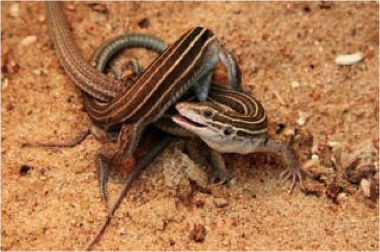39 Introduction to the Evolution of Sex
Sex is not always what it seems
It is difficult to mistake whiptail lizard copulation for anything else (Figure 1). A lizard mounting another lizard from behind certainly suggests sex. However, whiptail lizards of the genus Apidoscelis are all females and reproduce asexually. Eggs are produced through meiotic division, but then undergo a doubling of chromosomes to return to a full set of chromosome pairs. This type of asexual reproduction, in which embryos develop from unfertilized eggs, is called parthenogenesis (from the Greek, meaning “virgin birth”), and is seen in many plants and animals.
These lizards are doubly intriguing because they may exhibit a stereotypical mating behavior; in fact, this behavior has been shown to increase the number of offspring the lizards produce (even though there are no sperm involved!).
Species like the whiptail lizards highlight the major problem with sex. There are many asexual organisms such as these lizards (figure 1), and they appear to be doing just fine without sexual reproduction. This ability to thrive without sex demands an answer to the question: why does sex exist? Why would any organism incur all the costs associated with sexual reproduction, if asexual reproduction has so many obvious advantages?

Disentangling sex and reproduction
In the realm of biology, the terms sex and reproduction are often intertwined, yet they represent distinct processes that play unique roles in the survival and evolution of organisms. Understanding the difference between these two concepts is necessary to understand the evolution of sexual mechanisms, reproductive behavior, and their impacts on genetic diversity.
Reproduction is the biological process through which organisms produce new individuals of the same species. It ensures the continuity of genetic material from one generation to the next and can occur through two primary modes:
- Asexual Reproduction: In this mode, a single organism gives rise to offspring without the involvement of gametes (sex cells). The offspring are genetically identical clones of the parent, barring any mutations. Examples include:
- Binary Fission in bacteria, where a single cell divides into two identical cells.
- Budding in yeast and hydra, where a new organism grows from a particular site on the parent.
- Vegetative Propagation in plants, such as runners in strawberries.
- Parthenogenesis in whiptail lizards, as mentioned above.
- Sexual Reproduction: This involves the fusion of gametes from two individuals, leading to offspring with a combination of genetic material from both.
Sex, in a biological context, refers to the process of combining and mixing genetic material, often leading to new genetic combinations in the population. This exchange can occur with or without the act of reproduction. For example, conjugation in bacteria involves the transfer of a plasmid or a piece of DNA from one bacterium to another via a pilus, a hair-like cell-surface appendage that acts a conduit between the two cells. This does not result in new bacterial cells, but can accelerate the spread of new genetic variation.
VISUAL CONNECTION
Conjugation and the evolution of antibiotic resistance in bacteria.
Understanding that sex and reproduction are separate processes allows biologists to explore how each process evolves and influence the evolution of related characteristics and behaviors.
This chapter is licensed under a Creative Commons Attribution-NonCommercial-ShareAlike 4.0 International License

